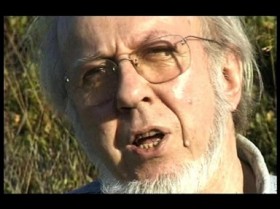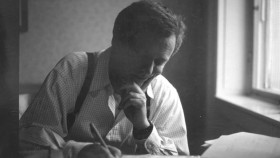Præsten i Askov, Hasse Neldeberg Jørgensen, åbnede for nogen tid siden sin KIRKE-BIO-CAFÉ med et program, som hed ”Forfatterfilm”. Jeg havde fået opgaven at introducere, havde forinden valgt Lars Johanssons ”Højholt” (1997) og Jørgen Leths ”Jeg er levende. Søren Ulrik Thomsen, digter” (1999) og måtte nu, før vi kørte filmene, give et bud på, hvad forfatterfilm egentlig er for noget. Jeg var omkring Henrik Poulsens bog ”Litteraturens film” (2005), som behandler en række film, især med henblik på undervisning, men havde mere direkte og præcis hjælp af Mette Lundens overvejelser i hendes omfattende essay ”Forfatterfilm” (2009), som er skrevet ind i en biblioteksfaglig forståelse. Mette Lundens afhandling, skriver hun, ”…viser dels, at der kan opstilles en meningsfuld systematik, dels at en gruppe af de såkaldte forfatterfilm i kraft af det levende billedes særlige skrift bidrager væsentligt til den biografiske genre som helhed ved med sin sociale og eksistentielle refleksion at udgøre et alternativ til en aktuel privat- og personfokuseret tendens i den skrevne biografi. ” Og lige netop det karakteriserer de to film, vi så og talte om.
Efter et interessant skema, Mette Lunden har stillet op med et forslag til forfatterfilms genrerubricering ses de begge at kunne defineres som portrætfilm, som Lunden bestemmer som ”filmessays over biografisk stof med filminstruktørens blik som det, filmene handler om, og en bestemt filosofisk, æstetisk vinkel med nedslag i forfatterens værk og liv”, det er film MED en forfatter, altså ikke OM en forfatter, hvad det er i en genre, Lunden kalder ”biografisk dokumentarfilm”. Andre forfatterfilm er således filmatiseringer af litterære værker, spillefilm over forfatterbiografier og biografiske dokumentarfilm, som skilles ad ved tilsvarende præciseringer.
Så tydeligt lykkedes det mig naturligvis ikke at stille det op i introduktionen til de to film en hyggelig aften i et lunt lokale med vin på bordet, men det blev alligevel i de efterfølgende samtaler i en sådan ramme, vi forstod filmene.
TO PORTRÆTFILM
De to film, ”Højholt” og ”Jeg er levende” klæder hinanden sådan en aften. De er forskelligt smukke, forskelligt morsomme, og så har de en række sammenlignelige punkter som temaer med to variationer: Begge medvirkende skribenter skriver i hånden. Det skildrer begge film. Højholt skriver med kuglepen og Thomsen med fyldepen. Begge skriver også på skrivemaskine. I en scene kæmper Højholt med sine maskinskrevne A4 ark med rettelser, rettelser. I en scene demonstrerer Thomsen tilfreds et digts grafiske skulptur på et renskrevet ark. Begge medvirkende har skrevet store poetikker, Højholt ”Cézannes metode” (1967) / ”Intethedens grimasser” (1972) og Thomsen ”Mit lys brænder” (1985) / En dans på gloser (1996), og Henrik Poulsen læser da også ”Jeg er levende” som en poetik i filmisk form og faktisk, talte nogle af os om, kan begge film læses som filmpoetikker på et indhold af litterære poetikker. Til det kommer, at begge filminstruktørerne, både Leth og Johansson er skrivende. Johansson skriver romaner og Leth skriver alt andet end romaner, og rigtig meget og er som Johansson fagligt optaget af den litterære proces. Hvordan bærer de andre sig ad?
”Jeg er levende” er titlen på Leths film, og vi konstaterede, at Johanssons film kunne have heddet ”Jeg er døende”, Højholt siger et sted, at romanen, han skriver på, ”Auricula” er én eneste vits om døden, og han arbejder samtidigt intenst med en tekst om digteren Ekelöfs død, mens han forbereder sig på sit eget næste infarkt. Han er i en afviklende proces, mens Thomsen i sin livsfase for første gang måske er i selvbiografiens energi: ”… finder gamle digte / breve erindringer / 10 år 8 år 7 år 1 år / jeg er levende…” Filmene skildrer for så vidt det samme, for fasernes lighedspunkter er mange, og begge forfattere er ikke bare i live, de er intenst i live.
Så er der det, (som den aften var relevant der i præstens konfirmandstue for et par timer omdannet til cafébiograf med den nye smartboard som vigtigste inventar), begge skildrede forfattere forholder sig til kristendommen, meget tydeligt. Thomsen er aktiv og praktiserende kirkegænger, har altid været det. Højholt lærte af sin far, at ”det der med Jesus skulle han ikke tage sig af”, og det gjorde han derefter ikke. Men vi der i konfirmandstuen vidste jo nok, at så let var og er det nu heller ikke her i vores samfund at se bort fra kristendommen, vi så på hinanden med glimt i øjnene – i en smartboardbio er der så meget lys, at man ser hinanden. (Det er mere tv-stue end biograf, og det er en vigtig del af oplevelsen, som man skal tage med i betragtning, når man forbereder sig, lærte jeg. Måske er det muligt at tale med hinanden, mens filmen kører, tage mod til sig og komme med en bemærkning? Det er ikke en irritation, men en særlig, ny kvalitet at se film sammen med et publikum, jeg samtidig ser se den samme film. Se og høre deres reaktion, dele min egen frit. (Som at se film på tv med dem derhjemme, men med disse fremmede uden denne selvfølgelighed.)
HØJHOLT
Da jeg skulle forberede det her, fandt og læste jeg Lars Movins anmeldelse fra dengang. Han er forbeholden, vist især fordi, han ikke finder Højholt i den form, han havde forventet. Han bemærker blandt meget andet: ”Man skal passe på ikke at blive for fiks på fingrene, siger Per Højholt. Hvis man bliver for dygtig, kommer tingene for let, og så mister de noget af den spændstige nervøsitet, der gjorde de første livtag med kunsten til noget særligt. Det kan virke, som om filmmageren Lars Johansson har forsøgt at tage ved lære af Højholts indsigt. I sit 58 minutter lange videoportræt – med titlen Højholt – fremstår den fotografuddannede Johansson som en professionel, der tilstræber et spontant og næsten amatøristisk filmsprog, en improvisatorisk ligefremhed, der ikke lægger skjul på filmens egen tilblivelsesproces. Man ser Johansson med kameraet – filmet af en anonym andenfotograf – og unoder som rystelser, ujævne zooms og usikre fokuseringer lægges med demonstrativ konsekvens frem for publikum. Stilen er givetvis affødt af nødvendighed. Højholt er tydeligt svækket, stemmen er sprukken, gangen usikker og talen uden tidligere tiders spændstighed. Hertil kommer, at den minimalistiske tilgang – en filmmager og en forfatter – synes at være et rimeligt valg til et menneske, der i tredive år har foretrukket den ensomme tilværelse i skovene omkring Silkeborg. Hensigten har tilsyneladende været at lade filmen have notatets og researchsamtalens søgende karakter. Men eksperimentet er kun delvist lykkedes…”

Derefter så jeg selvfølgelig Johanssons film igen, og jeg så, at Movin selvfølgelig læser og beskriver filmen præcist og dækkende, men jeg mener nu, jeg ser filmen efter de mange år, at han har uret i konklusionen, eksperimentet ser for mig ud til at være lykkedes helt som tænkt. Afdæmpetheden hos Højholt gør først ham, så filmen tydeligere. Det er med vilje, den begynder i en nervøs usikkerhed, sådan er det samvær, det måske begyndende venskab, filmen skildrer, sådan er filmen, jeg er i, det er dens koncensus. Det begynder i usikkerheden med det håndholdte kamera, og klipperen Ghita Beckendorff vælger med sikker hånd at bevare ellers kassable optagelser, for deres anderledeshed vil hun stille og roligt konvertere til en præcision i skildringen af den akavede situation, begge de to generte mænd er i, og langsomt udvikle til en gensidig fortrolighed og forståelse af hinanden og af hinandens projekt. Fotografen prøver vinkler og beskæringer af, og digteren smager på sine formuleringer, lytter til sig selv, ja, faktisk i scenen, som den klippes, det er også et Beckendorff-greb, som tydeliggør filmens ærinde at være en filmisk poetik, som skildrer en litterær poetik i det, som Højholt nok ville kalde praksis. Samværets, samtalens, mulighed for at gribe alt det informationstunge i en gensidig lethed, fastholde Højholts oneliners, som jeg får lyst til at skrive som notater hele tiden, imens bladene falder og årstiderne bliver til filmiske kapitler.
JEG ER LEVENDE
Jeg husker tydeligt, da jeg så den film første gang. Husker den følelse af ro, som greb mig: filmen begynder i kompetence, jeg er tryg og i sikkerhed. Og jeg vil blive bragt i tvivl og i anfægtelse, men ikke i usikkerhed om filmen. Det jeg hører først er Søren Ulrik Thomsens sikkerhed i sproget, det, jeg så ser, er Dan Holmbergs intuition i sin nødvendige enegang (som jeg har læst Thomsens beskrivelse af), og så ser jeg Camilla Skousens gennemprøvede og alligevel hver gang nyskabende filmdigt greb, hendes viden om juxtapositionernes styrke, at 1+1=3. Dette mærkværdige postulat, som er en indsigt. Bag alt dette læser jeg så Jørgen Leths samlede tanke.

”Filmen er fra 1999 og er et slags bestillingsarbejde, idet Søren Ulrik Thomsens forlag ønskede at lave en portrætfilm med digteren, der til gengæld gjorde det til et ultimativt krav, at skulle der laves en film, skulle den laves af Leth. Søren Ulrik Thomsen ønskede at filmen skulle være Leths. Det skulle være en film, som Leth kunne kalde sit værk. Søren Ulrik Thomsen ønskede overhovedet ikke at blande sig i, hvordan jeg lavede den. Han ville stå til rådighed’, har Jørgen Leth senere fortalt. Leth, der selv skriver digte, beundrer Søren Ulrik Thomsens arbejde, og fandt det en stor udfordring at skulle arbejde med en anden digters ord. I første omgang sagde filminstituttets konsulent imidlertid nej til at finansiere filmen med den begrundelse, at Leth ville fylde for meget i forhold til Søren Ulrik Thomsen. Interessant ved historien er en problematik om, hvem der er autor og hvem og hvad et portræt i virkeligheden portrætterer. Enden på det blev en usædvanlig fin film, der har opnået høj status, og glædet såvel læserne af filmen, som Leth og Søren Ulrik Thomsen selv. Vi får nogle ganske få biografiske historier; hvordan Søren Ulrik Thomsen i skolen holdt meget af salmevers, hvordan hans far pakkede børnene ind i opvarmede dyner og sang godnatsalmer for dem i hjemmet på Stevns, og hvordan det gik for sig, når hele familien besøgte morbror Børge i Kongens have. Det er nok – vi er helt med – og har fattet vigtige stemninger fra fortiden, der ligger bag Søren Ulrik Thomsens vej til digtningen.”
HVEM ER AUTOR?
Mette Lunden, som skriver her, understreger altså: ”Interessant ved historien er en problematik om, hvem der er autor og hvem og hvad et portræt i virkeligheden portrætterer…” Og det rejser så mit berettigede spørgsmål som publikum, som læser: Hvad er fortællepositionen? Hvem fortæller, hvem er det, som udreder det essay om poetik, som er filmens? Er det i de to film Højholt eller Johansson, Thomsen eller Leth? Hvem er det, der skriver en forfatterfilm? Og hvem skildrer portrættet? Modellen eller maleren?
Rembrandt har malet et portræt af Jan Rijcksen og hustruen Griet Jans. I 1633. Det hænger på Buckingham Palace. Først i 1970-erne fandt en kunsthistoriker ud af, at Rijcksen var skibsreder og skibsbygger, altså en vigtig person i Amsterdam dengang, i virkeligheden vigtig for hollandsk historie i perioden. Men hvad så den engelske dronning før 1633? Hvilken omverdenstolkning? Et ukendt par i Amsterdam i 1600-tallets blik på verden eller Rembrandts? Hvordan mon i dag? Ser hun det som et Rijcksen-portræt eller som et Rembrandt-portræt?
Lars Johansson: ”Højholt”, Danmark , 1997, 58 min.
Jørgen Leth: ”Jeg er levende – Søren Ulrik Thomsen, digter”, 1999, 40 min.
Litt.:
Henrik Poulsen: ”Litteraturens film”, Gyldendal, 2005.
Mette Lunden: ”Forfatterfilm. Det audiovisuelle skønlitterære biografiske værk”, 2009. Ikke trykt manus, Danmarks Biblioteksskole, Aalborg Afdelingen.
Lars Johansson: “Udsatte egne – det er mig”. Samtaler med Per Højholt, Borgen 1998.
Søren Ulrik Thomsen: “Intet mindre end magisk”, i “The Jørgen Leth Collection. Portrætfilmene”, Det Danske Filminstitut, 2008.
Lars Movin: “Alt er i billedet”, Gyldendal 2013, 132ff (Om “Jeg er levende”)
Link: Lars Movins anmeldelse af “Højholt”
Link: Henrik Poulsen: “Filmisk poetik”
Foto: H. C. Andersens håndskrift. Vi kender portrætterne af ham, fotografierne og malerierne, hans biografier. Men fotografen, maleren, biografiforfatteren? Alene selvbiografien kan vi nævne. Den kan vi på en måde udenad. Er det værkernes kunstneriske styrke eller er det vore valg, som afgør det?




